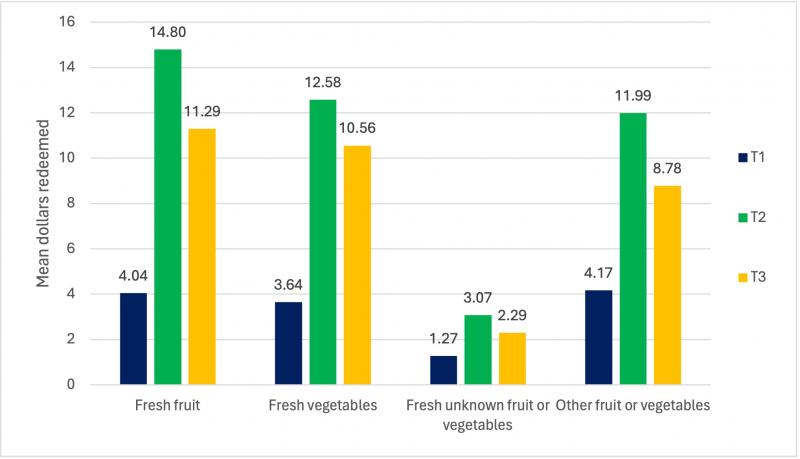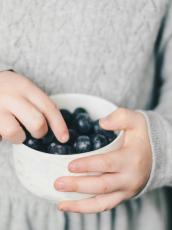Enhanced WIC Benefits Boost Purchasing of Fruit and Vegetables Among Low-Income Families
By Christopher E. Anderson, PHFE-WIC, a program of Heluna Health; Lauren E. Au, UC Davis; Catherine E. Yepez, PHFE-WIC; Lorrene D. Ritchie, UCANR; Marisa M. Tsai, UCANR; and Shannon E. Whaley, PHFE-WIC
Special Supplemental Nutrition Program for Women, Infants, and Children (WIC) food packages for children aged one to four years include a cash value benefit (CVB) redeemable for fruits and vegetables with participating vendors. Beginning in June 2021, the CVB value was increased. In a recent study, we evaluated associations of the augmented CVB with the amount and diversity of redeemed fruits and vegetables. We found that the augmented CVB was associated with greater and more diverse purchases of fruits and vegetables. Our results suggest that policies designed to increase the value of benefits like WIC can help improve access to high-quality foods among children from low-income families.
Key Facts
- In June 2021, the cash value benefit (CVB) of WIC food packages for children aged one to four was increased.
- The augmented CVB was associated with greater and more diverse purchases of fruits and vegetables.
- Policies designed to increase the value of benefits like the WIC CVB can help improve diet quality among children from low-income families.
Background
Low diet quality is pervasive among young children in the United States, with notably low combined intakes of fruits and vegetables that are more pronounced among children living in low-income households.[1,2,3] Shortfalls from healthy diets among children occur concurrently with high and increasing obesity prevalence among young children, during an age period in which optimal nutrition is critical to both healthy growth and development of lifelong eating habits.[4,5] Unfortunately, fruits and vegetables are the foods most frequently rejected by young children, and interventions to increase child fruit and vegetable intake have struggled to contribute to significant increases.[6,7]
The Special Supplemental Nutrition Program for Women, Infants, and Children (WIC) is a nutrition-assistance program of the US federal government that provides support to pregnant and postpartum women living in low-income households and their infants and children under age five years with the aim of supporting healthy diets during these important life stages.[8] WIC provides four core services including food packages redeemable at approved vendors for select healthy foods and beverages, nutrition education, breastfeeding support, and health and social service referrals.[9] In 2021, WIC served 6.2 million people, including 3.4 million children aged one to four years.[10] WIC food packages were revised in 2009 to include a cash value benefit (CVB) for fresh fruits and vegetables, in addition to canned and frozen fruit and vegetables, and these food package changes were associated with significant improvements in the diets of participants, though diet quality among WIC-participating children has remained suboptimal.[11,12]
In June 2021, the WIC CVB was increased from 9 USD/mo to 35 USD/mo and was revised further to 24 USD/mo from October 2021 to September 2022. The CVB was increased to 25 USD/mo for the period of October 1, 2022–September 30, 2023. In our study, we sought to find out the extent to which the augmented CVB helped to improve diet quality among children from WIC-eligible families by increasing and diversifying their access to fruit and vegetables.
Measuring the Effects of Increased WIC Benefits
We analyzed the purchases of 1578 WIC-participating families in Los Angeles Country, California from June 2020 to June 2022. For analytical purposes, we divided this period into three sections: T1 (June 2020–May 2021), T2 (June 2021–September 2021), and T3 (October 2021–June 2022), reflecting three different values of the CVB for children (9USD, 35USD and 24USD). These families contained at least one child aged one to four; the total number of such children in our final sample was 1770. We assessed redemption of the CVB using WIC administrative data from electronic benefit transfer transactions with multiple outcomes for 54 specific commodity groups describing closely related types of fruits and vegetables. We measured the dollar amount redeemed for fruit and vegetables, as well as the diversity of redemption and the percent of total CVB redemption. We then analyzed how these measures varied before and after the CVB value was increased.
Higher WIC Value Associated with Greater, More Diverse Fruit and Vegetable Purchases
At T2 and T3, compared with T1, we found that redemption was significantly higher for 29 of 30 evaluated vegetable categories (see Figure 1). Vegetables that saw large increases included avocados, potatoes, carrots, and kale. Similarly, all 24 evaluated fruit categories saw significantly higher redemption at T2 and T3, compared with T1. Large increases were observed for apples, lemons, mangoes and nectarines. The dollar amount redeemed increased for fresh fruit by $10.62 at T2 and $7.27 at T3. For fresh vegetables, it increased by $9.13 at T2 and $6.93 at T3. For other fruit and vegetables, redemption increased by $7.38 at T2 and $4.17 at T3.

Figure 1: Mean dollars redeemed on different categories of fruit and vegetables in T1, T2, and T3.
The percent of CVB redeemed on fresh vegetables increased at T2 (1.06 percent) and T3 (3.09 percent). The percent redeemed on other fruit and vegetables increased at T2 (1.50 percent). The percent redeemed on fresh fruit increased significantly at T2 (1.88 percent). Diversity scores increased significantly for fresh fruit at T2 (16.32 points) and T3 (9.23 points). The same was true for fresh vegetables, which saw a diversity score increase of 19.71 points at T2 and 13.53 points at T3. For all fresh produce, diversity scores increased by 30.25 points at T2 and 21.28 points at T3. All of these increases were compared with T1.
Extending WIC Augmentation Likely to Improve Nutrition Among Disadvantaged Children
The increase of the WIC CVB beginning in June 2021 was associated with significant increases in the dollar amount redeemed for fruits and vegetables; significant increases for the diversity of redeemed fruits, vegetables, and all fresh produce; and a significant increase for the proportion of total CVB redemption accounted for by fresh fruit at the highest CVB amount among WIC-participating households in Los Angeles County, California. The increased amount and diversity of redemption was observed in both the monthly prevalence of any redemption and monthly dollar amount redeemed, with significant increases observed for 53 of 54 commodity groups of fruits and vegetables following the introduction of the increased CVB.
Our study demonstrates that the increased WIC CVB was well received by participating households and allowed families to redeem greater amounts of various fruits and vegetables. The increased diversity of fruits and vegetables redeemed following the augmented CVB should be considered a success in increasing access to sufficient amounts and diversity of fruits and vegetables among low-income households.
Since increased diversity of redemption contributes to improved household access to diverse fruit and vegetables, and could therefore contribute to more diversity in child fruit-and-vegetable intake, policy makers should consider the potential of the increased WIC CVB in improving the diets of children in low-income households. As our findings suggest, maintaining the augmentation of fruit and vegetable benefits for children will likely have a positive impact on nutrition among disadvantaged families.
Christopher E. Anderson is an associate research scientist at Public Health Foundation Enterprises (PHFE) WIC, a program of Heluna Health.
Lauren E. Au is an assistant professor of nutrition at UC Davis.
Catherine E. Yepez is an associate research scientist at Public Health Foundation Enterprises (PHFE) WIC, a program of Heluna Health.
Lorrene D. Ritchie is director of the Nutrition Policy Institute in the University of California Division of Agriculture and Natural Resources.
Marisa M. Tsai is a research data analyst at the Nutrition Policy Institute in the University of California Division of Agriculture and Natural Resources.
Shannon E. Whaley is director of research and evaluation at Public Health Foundation Enterprises (PHFE) WIC, a program of Heluna Health.
References
1. US Department of Agriculture and US Department of Health and Human Services. Dietary Guidelines for Americans. 9th Edition. 2020–2025 [Internet], December 2020. https://www.dietaryguidelines.gov/
2. Kim S.A., Moore L.V., Galuska D., Wright A.P., Harris D., Grummer-Strawn L.M. et al. Vital signs: fruit and vegetable intake among children – United States, 2003-2010. MMWR Morb. Mortal Wkly. Rep. 2014; 63: 671-676
3. Di Noia J., Byrd-Bredbenner C. Determinants of fruit and vegetable intake in low-income children and adolescents. Nutr. Rev. 2014; 72: 575-590 https://doi.org/10.1111/nure.12126
4. Ogden C.L., Carroll M.D., Lawman H.G., Fryar C.D., Kruszon-Moran D., Kit B.K. et al. Trends in obesity prevalence among children and adolescents in the United States, 1988-1994 through 2013-2014. JAMA. 2016; 315: 2292-2299 https://doi.org/10.1001/jama.2016.6361
5. Schwarzenberg S.J., Georgieff M.K. Committee on Nutrition, Advocacy for improving nutrition in the first 1000 days to support childhood development and adult health. Pediatrics. 2018; 141e20173716 https://doi.org/10.1542/peds.2017-3716
6. Cooke L., Carnell S., Wardle J. Food neophobia and mealtime food consumption in 4-5 year old children. Int. J. Behav. Nutr. Phys. Act. 2006; 3: 14 https://doi.org/10.1186/1479-5868-3-14
7. Hodder R.K., O’Brien K.M., Stacey F.G., Wyse R.J., Clinton-McHarg T., Tzelepis F. et al. Interventions for increasing fruit and vegetable consumption in children aged five years and under. Cochrane Database Syst. Rev. 2018; 5: CD008552 https://doi.org/10.1002/14651858.cd008552.pub5
8. Oliveira V. Frazao E. The WIC Program: Background, Trends and Economic Issues. Edition, EIB-134. US Department of Agriculture, Economic Research Service, 2015 (2015)
9. WIC Program [Internet]. US Department of Agriculture, Economic Research Service. Available from: https://www.ers.usda.gov/topics/food-nutrition-assistance/wic-program.aspx
10. WIC Data Tables: National Level Annual Summary. US Department of Agriculture, Food and Nutrition Service, 2023. https://www.fns.usda.gov/pd/wic-program
11. Taylor J. Updating the WIC food packages: it’s about time, Issue Brief George Wash. 816. Univ. Natl. Health Policy Forum, 2006: 1-14
12. Whaley S.E., Ritchie L.D., Spector P., Gomez J. Revised WIC food package improves diets of WIC families. J. Nutr. Educ. Behav. 2012; 44: 204-209 https://doi.org/10.1016/j.jneb.2011.09.011










